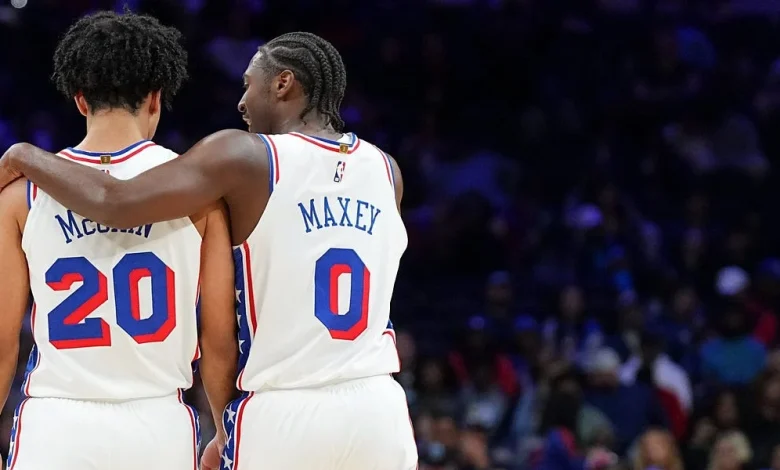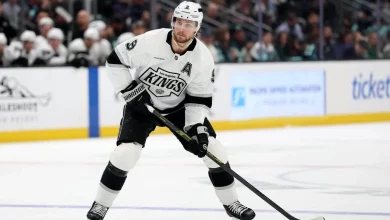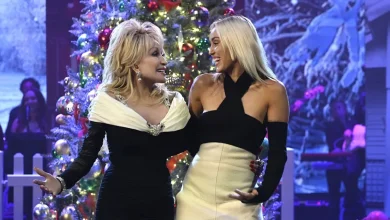Five Thoughts on the Sixers’ First 16 Games

The Sixers are 9-7, and while that’s not some earth-shattering record, it’s surprisingly easy to feel good about where they’re at, especially given the injuries they’ve dealt with. If I had told you six weeks ago that the Sixers would start the season 9-7 with fewer than 300 combined minutes from Joel Embiid, Paul George, and Jared McCain, would you have been satisfied with that?
I think most Sixers fans would have. It has taken us 12 years to get here, and the Sixers can still prove that their ceiling is higher than this — but as Spike and Mike said on the pod last week, I think it’s fair to say that we’re all coming around to appreciate a team that is just… pretty good!
The Sixers are a mostly young, mostly competent basketball team, with some annoying quirks but lots of charm. Nearly 20 percent of the way through the season, we can say at the very least that this team is a fun nightly hang, with the upside to become something more. With that in mind, let’s get into some key takeaways from the Sixers’ 9-7 start.
I just keep running out of compliments to give to Tyrese Maxey. I repeatedly find myself watching these games and saying to myself, “I just can’t believe he’s this good.”
The show that he put on in Milwaukee on Thursday night – 54 points, nine assists, five rebounds, three steals, and three blocks in an overtime win – was likely the best game I’ve ever seen him play. I don’t say this lightly: It reminds me of the feeling I got watching Embiid 4-5 years ago where you started to notice that he has mastered the offensive end of the basketball court.
Maxey can do absolutely everything. He can drive and finish with either hand (he set a season record for most layups made with his off-hand in one game!). He’s got a lethal step-back 3, a crazy first step off the dribble, and a crafty midrange bag. He can fly around screens or run sideways into catch and shoot 3s. He can throw almost every pass in the book. He simultaneously feels in control, never sped up, and also faster than everyone else. He’s incredible. We are nearly 20 percent of the way through the season, and he is fifth in MVP odds on DraftKings. And deservedly so!
With that being said, I still feel there is room for improvement with Maxey,, specifically in terms of how Nick Nurse uses him. Just because he can do everything doesn’t mean that the Sixers shouldn’t try to structure the offense to tilt towards his biggest strengths.
If you look at the stretches of games where Maxey struggles and the offense sputters, it’s almost always because Nurse has turned the offense into Maxey isolating from 30 feet out like he’s James Harden. While he can do that for stretches, that is simply not the best way to use him, and the numbers back that up.
As of the weekend, Maxey was 12th in the league in isolation possessions per game, but his efficiency there was pretty dreadful – just 0.66 points per possession. For context, that was fifth on the Sixers alone. Maxey was also among the league leaders in pick and rolls per game, but with far-from-elite efficiency in those situations, averaging just 0.91 points per possession.
Contrarily, Maxey had been absolutely elite in dribble hand-offs, generating 1.39 PPP out of those situations — and ridiculously good (1.54 PPP) when coming off of off-ball screens. He was also in the elite tier of spot-up threats, generating 1.23 PPP in those situations.
So, while it’s a small sample size, the stats show an obvious trend, which we already somewhat knew. Maxey is one of the best in the world at working with a dribble hand-off partner to generate good looks. He can develop chemistry in a heartbeat with everyone from Joel Embiid to Trendon Watford. He is also one of the best off-ball shooting threats in the entire league, both in spot-up and off-screen situations. But when you ask him to be primarily a pick and roll and isolation threat, his efficiency isn’t among the best in the league. Can he do it? Yes. Is it the best use of him? No.
Knowing that, my plea to Nick Nurse would be to use Maxey a little more like Steph Curry and less like James Harden. I realize that this runs contrary to what Nurse is inclined to do, and Maxey’s raw numbers are great as they are, but knowing what we know about Maxey’s strengths and how they show up in the efficiency stats, the Sixers would be foolish not to tap into that side of Maxey even more. He has been one of the best offensive players in the league so far this season, and he can be even better.
Part of the challenge of watching this Sixers team is going to be recalibrating your expectations depending on what the injury report says on a nightly basis. Of course, you’d be reasonable to expect a full strength Sixers team to win 65 percent of their games and beat the brakes off of bad teams. But those are going to be special occasions. You have to accept that most nights, you’re going to be watching The Regulars – the four guards plus role players – fighting like hell to skate by a mediocre opponent.
That of course is not a condemnation or complaint about The Regulars. I really am enjoying the viewing experience so far! They are 4-3 in games without both George and Embiid, and you’d be reasonable to expect that pace to continue. But I would just caution any Sixers fan who is unconsciously stuck in the title-or-bust mindset of three years ago – these are different times. There are no more automatic wins. No more blowouts where the starters rest in the fourth quarter. Most nights, you’re going to be watching a team that would lose roughly half of its games if stretched over the course of a full season.
Now, with all of that being said, I think you’d have to feel pretty good about the fact that the Sixers’ roster can win half of their games with $110 million on the bench. If The Regulars are able to hold onto their .500ish win pace, this team is without a doubt going to make the playoffs. Adding George and Embiid to this team – even the current versions of those two guys – is pretty exciting to think about. I’ll wait until we see it for a week or two before I start daydreaming about what a playoff run might look like, but based on what we’ve seen from George and Embiid in the stretches that they’ve been healthy this year? Yeah, I think this team could do some real damage if by some miracle they both stayed healthy for April and May.
I just wanted to give a quick tip of the cap to Andre Drummond, who was legitimately one of the worst players in the NBA last season, and now looks much more like himself. He has clearly lost weight and is moving much more like he did during his 2021 run with the Sixers than his 2024-25 season.
I keep expecting this to fall off, but the Sixers are winning Drummond’s minutes by a considerable margin – they have a net rating of +7.3 when he is on the floor. If that holds, it would be the best mark for a backup center in the entire Embiid era.
I’m also a believer in the three point shot. He’s at 40 percent on two attempts per game! Let it fly, big fella.
Evaluating Joel Embiid’s Start to the 2025-26 Season
One of the concerns that I expressed throughout the summer was that, while it’d be foolish to make a huge win-now trade, the trio of Trendon Watford and two two-way guys might leave such a catastrophic weakness at the power forward spot that the team (like last year) is simply too small to compete in any real way.
I no longer hold that concern. Barlow and Walker, in particular, have done just enough and have been the exact right fit to allow the other strengths of this roster to shine through. They are ferocious rebounders who can guard multiple positions – that is really all the Sixers needed.
The winning formula for the Sixers – for The Regulars, at least – is star-quality play from their guards and competence everywhere else. Consider the latter box checked. I give credit to Daryl Morey and co. for filling this need without having to use any real assets. And barring some incredibly favorable deal popping up at the trade deadline, I’d be fully content to let this roster ride out the rest of the year without adding anything else to the power forward rotation.
It’s been good to see some shots go down for Jared McCain over the last few games, but consider me still mildly concerned about the situation on multiple levels. The most concerning part is, of course, the fact that he has looked like a shell of himself when he’s played. He had his best shooting game of the season on Sunday, scoring 15 points and hitting 3-4 from deep (but just 2-7 from two). Before that, though, he was averaging just 2.2 points per game on 21 percent from the field in 10.3 minutes per game. And the eye test was just as bad as the stats – he’s looked visibly slower than last season, and was uncomfortable dribbling the ball anywhere near a defender. He has struggled just to get shots off, let alone make one.
But beyond that, I’m worried about the overall outlook and approach that the team is taking towards him, and this is a concern I’ve had for a while. To put it simply, I worry that the organization as a whole is massively underreacting to the season McCain had last year. I think that Nick Nurse’s decision to play him for ultra-limited stretches and bench him whenever he struggles is partly a reflection of that – at the very least, it doesn’t seem like getting McCain back in a rhythm is all that much of a priority to him. Again, the only time he has played more than 15 minutes in a game this season was Sunday against the Heat, which was basically by necessity given that V.J. Edgecombe was out.
You may also recall that last season, even after McCain exploded for 24.3 points per game for a nine game stretch in November, Nurse yanked McCain back out of the starting lineup as soon as the team’s backcourt became fully healthy, opting not to start him alongside Maxey. He came off the bench for five of his last six games prior to tearing his meniscus, with a couple of those games curiously featuring only around 20 minutes of run for McCain. That might seem like a small decision looking back, but given how awful last year’s team was and how incredible McCain’s breakout was, it was a genuinely baffling move at the time.
Even Daryl Morey, in an RTRS appearance prior to the draft lottery, repeatedly expressed his confidence in a future Maxey-Grimes backcourt, emphasizing the defensive fit between those two and making a perhaps purposeful, perhaps accidental omission of McCain. Throughout the interview, Morey just generally never expressed the type of praise for McCain that most Sixers fans would expect.
If my tea-leaf reading is correct, and Morey and Nurse do not in fact view McCain in the same light that us fans do, I simply don’t know what the hell they watched last season. Those 23 games were insanely special. I felt like I was watching a perennial future All-Star. The fact that it isn’t a bigger priority to get McCain up to speed is just bizarre to me; getting last year’s version (or better!) of McCain would make this team way, way better. They need his spacing, his shot creation, and more so than anything, his ability to allow Maxey to play less than 40 minutes per game.
The fact that he has struggled so much is a huge bummer. Maybe it’s partly injury related, but if it is just a matter of rhythm and conditioning, the Sixers are prolonging this process for no obvious reason. He needs to play. I am clueless as to why we keep seeing his minutes in the single digits. Everyone involved should know better. He should be considered a massive part of this team’s future, and I worry that the team may not view things that way.
Mike O’Connor is the best O’Connor in basketball writing. Previously of The Athletic, you can find Mike on Twitter @MOConnor_NBA. Mike’s writing is brought to you by Body Bio, supplements based on science, focusing on your gut and brain health.




